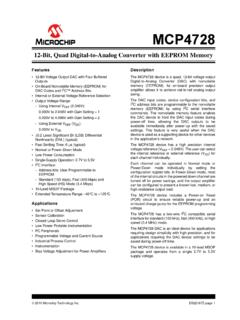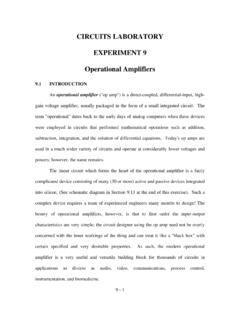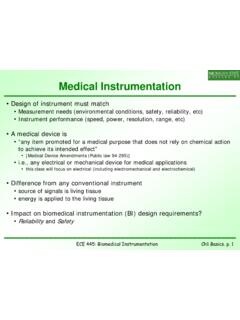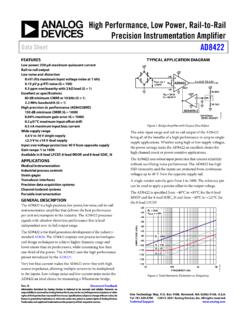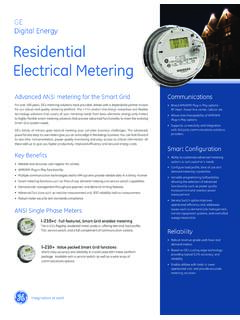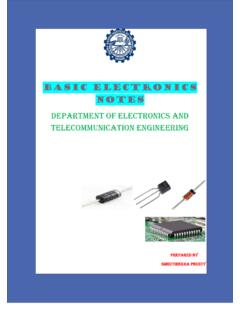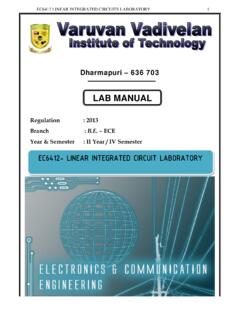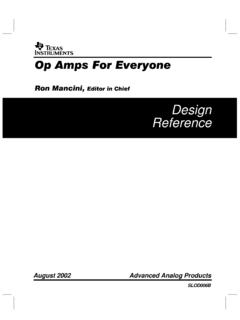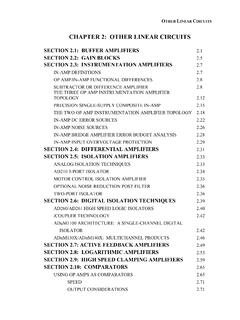Transcription of Handbook of Operational Amplifier Applications (Rev. B)
1 Application Report SBOA092B October 2001 S Revised September 2016. Handbook OF Operational Amplifier . Applications . Bruce Carter and Thomas R. Brown ABSTRACT. While in the process of reviewing Texas Instruments Applications notes, including those from Burr-Brown I uncovered a couple of treasures, this Handbook on op amp Applications and one on active RC networks. These old publications, from 1963 and 1966, respectively, are some of the finest works on op amp theory that I have ever seen. Nevertheless, they contain some material that is hopelessly outdated. This includes everything from the state of the art of Amplifier technology, to the parts referenced in the document even to the symbol used for the op amp itself: These numbers in the circles referred to pin numbers of old op amps, which were potted modules instead of integrated circuits.
2 Many references to these numbers were made in the text, and these have been changed, of course. In revising this document, I chose to take a minimal approach to the material out of respect for the original author, Thomas R. Brown, leaving as much of the original material intact as possible while making the document relevant to present day designers. There were some sections that were deleted or substantially changed: = Broadbanding Operational Amplifier modules replaced with discussion of uncompensated Operational amplifiers. = Open loop Applications and Comparators Applications showing an Operational Amplifier used open loop, as a comparator have been deleted. At the time of original publication, there were no dedicated comparator components.
3 Good design techniques now dictate using a comparator instead of an Operational Amplifier . There are ways of safely using an Operational Amplifier as a comparator if the output stage is designed to be used that way - as in a voltage limiting Operational Amplifier or if clamping is added externally that prevents the output from saturating. These Applications are shown. = Testing Operational Amplifiers a section that had become hopelessly outdated. Testing techniques are now tailored to the individual Amplifier , to test for parameters important to its intended purpose or target end equipment. 1. Search for TI op amps and technical resources SBOA092B. = Some other application circuits were eliminated if they were deemed impractical in the light of today's technology.
4 This Handbook has also been reorganized to eliminate some redundancy, and place all application circuits in one location. The reader is cautioned that proper decoupling techniques should be followed with Operational amplifiers. Decoupling components are omitted from Applications schematics in this document for clarity. Consult reference 2 for proper decoupling techniques. I also cleaned up grammatical and spelling mistakes in the original. --- Bruce Carter, Texas Instruments Applications (Excerpts from) Thomas Brown's original Preface: The purpose of this Handbook is to provide a single source of information covering the proper design of circuits employing the versatile modem Operational Amplifier . This manual will be helpful to the experienced user of Operational amplifiers, as well as the new user, in extending the range of potential Applications in which these devices can be used to advantage.
5 It is assumed that the reader will have a basic knowledge of electronics, but no particular knowledge of Operational amplifiers is needed to use this Handbook . The Operational Amplifier is treated as a circuit component inherently subject to certain rules of operation. The design of the Operational amplifiers themselves is considered only when necessary to describe their less evident properties. Readers with a working knowledge of Operational amplifiers will want to refer directly to the circuit collection. Readers whose job functions have not previously brought them in contact with Operational amplifiers will want to proceed directly through the Handbook until the desired degree of familiarity is obtained. Refinements are continuously being made in the design and application of Operational amplifiers, yet the basic principles of application remain the same.
6 Please do not hesitate to contact Texas Instruments at any time with questions or comments arising from the use of this Handbook . It is, after all, intended for you, the user. --- Thomas R. Brown, Jr. 2 Handbook OF Operational Amplifier Applications . Search for TI op amps and technical resources SBOA092B. Contents 7. Computation control instrumentation .. 7. The Feedback Technique .. 7. Notation and 8. Input 9. Output Terminals .. 9. Power Connections .. 10. Summary of Notation .. 10. Electrical Circuit Models .. 10. Circuit Notation .. 11. The Ideal Operational Amplifier .. 12. Defining the Ideal Operational 12. A Summing Point 13. CIRCUITS AND ANALYSES USING THE IDEAL Operational Amplifier .. 14. The Desirability of Feedback .. 14.
7 Two Important Feedback Circuits .. 15. Voltage 15. Non-Inverting Amplifier .. 17. INVERTING Amplifier .. 18. Intuitive Analysis 19. Current 20. Reactive 20. Integrator .. 21. 21. Voltage 23. Scaling Summer .. 23. Combining Circuit Functions .. 24. Differential Input 24. Balanced 25. Ideal-Real Comparison .. 27. CHARACTERISTICS OF PRACTICAL Operational 29. Open Loop Characteristics .. 29. Open Loop Operation .. 30. Output Limiting .. 30. FREQUENCY DEPENDENT PROPERTIES .. 31. 31. Open Loop Gain and the Bode Plot .. 31. Bode Plot Construction .. 31. Closed Loop 32. 33. Compensation .. 33. Compensation Changes .. 34. 35. Loop 35. The Significance of Loop 36. BODE PLOTS AND BASIC PRACTICAL 37. Voltage 37. Handbook OF Operational Amplifier Applications 3.
8 Search for TI op amps and technical resources SBOA092B. Inverter .. 37. X1000 Amplifier .. 38. 38. 40. OTHER IMPORTANT PROPERTIES OF Operational 41. Summing Point Restraints .. 41. Closed Loop Impedance 42. Output Impedance .. 42. Input 43. Differential Inputs and Common Mode 44. The Common Mode Voltage Limit .. 44. 44. Drift 45. Capacitive Loading .. 45. VOLTAGE DETECTORS AND COMPARATORS .. 46. Voltage Limiting Operational Amplifiers .. 46. THE VOLTAGE FOLLOWER .. 49. BUFFERS AND ISOLATION AMPLIFIERS .. 50. Inverting Buffer Adjustable Gain .. 50. Balanced 50. VOLTAGE AND CURRENT 50. Isolated Standard Cell .. 51. Constant Current Generator .. 51. Buffer 52. Presettable Voltage Source .. 52. Reference Voltage Supply .. 52. THE NON-INVERTING Amplifier .
9 53. THE INVERTING Amplifier .. 54. INTEGRATORS .. 55. PRACTICAL 55. Simple Integrators .. 56. Summing Integrator .. 58. Double 58. Differential Integrator .. 59. AC Integrator .. 59. Augmenting Integrator .. 59. 61. With Stop .. 61. Low Noise .. 62. Augmented 62. THE VOLTAGE SUMMER .. 63. SUMMING AND AVERAGING 64. 64. Scaling Adder .. 64. Direct Addition .. 65. 65. Weighted Average .. 66. THE DIFFERENTIAL INPUT 67. Adder-Subtractor or Floating Input Combiner .. 68. 4 Handbook OF Operational Amplifier Applications . Search for TI op amps and technical resources SBOA092B. THE DIFFERENTIAL (BALANCED) OUTPUT 69. DC AMPLIFIERS .. 70. Simple Inverting sign changing 70. Chopper Stabilized .. 70. Simple Gain 70. Linear Gain control .. 71. Simple Non-Inverting.
10 71. Power Booster .. 71. Differential 73. Gain control .. 73. Inverting Gain 73. DIFFERENTIAL AMPLIFIERS .. 74. 74. Difference Amplifier .. 74. Common Mode Rejection .. 75. Differential 75. AC AMPLIFIERS .. 76. DC Amplifiers with Blocking Capacitors .. 76. Simple Amplifier ..76. Single Supply ..76. Non-Inverting ..77. Double Rolloff ..77. AC Preamplifier ..78. CURRENT OUTPUT 79. Feedback 79. Simple Meter 79. Meter Amplifier .. 80. Current 80. Linear Current Source .. 81. Deflection Coil Driver .. 82. OSCILLATORS AND MULTI VIBRATORS .. 83. Simple 83. Wien Bridge Oscillator .. 83. PHASE LEAD AND LAG NETWORKS .. 84. Lag Element .. 84. Adjustable 84. Lag value linear with R setting .. 85. Adjustable 85. Lead-Lag .. 86. Time Delay .. 86.










